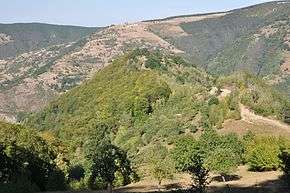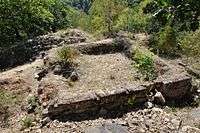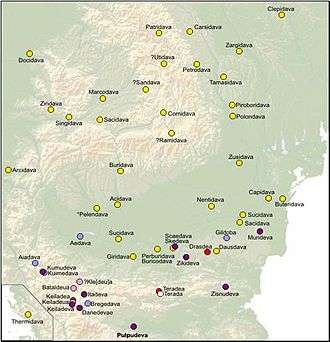Dacian fortress of Căpâlna
 Panoramic view from south-west of fortress hill | |
 Shown within Romania | |
| Location | Dealul Gărgălău, Căpâlna, Alba, Romania |
|---|---|
| Coordinates | 45°49′20″N 23°36′12″E / 45.822257°N 23.603470°ECoordinates: 45°49′20″N 23°36′12″E / 45.822257°N 23.603470°E |
| Altitude | 650 m (2,133 ft) |
| History | |
| Founded | c. 50 BC |
| Abandoned | 106 AD |
| Events | Trajan's Dacian Wars |
| Site notes | |
| Excavation dates | 1982 - 1983 |
| Archaeologists |
|
| Condition | Ruined |
| Reference no. | 906 |
| Reference no. | AB-I-s-A-00020 |

Situated at the top of a steep hill, the Dacian fortress of Căpâlna was built in the second half of the 1st century BC as a military defense, guarding the entrance from the Sebeș Valley to the capital of the Dacian kingdom, Sarmizegetusa Regia.
It is supposed that the fortress was the residence of a Dacian chieftain. Archeological findings include ceramics, iron and bronze tools, silver and bronze jewellry and Roman coins from the Republican and Imperial periods. Around 2002 - 2003 a gold necklace and two gold earrings were discovered here.[1]
The fortress was witness to Dacian - Roman battles during Trajan's Dacian Wars. In the first war, the fort was occupied by the Romans. Ultimately, it was burnt and destroyed by the Romans around 106 AD.
The fortress is encircled by an elliptical wall (c. 270 m long). The wall was partially destroyed during the first war, and was hastily rebuilt just before the second war.
Inside two terraces were found. On the higher level terrace, at the highest point, an observatory tower existed.
A tower house (9.5 m x 9.5 m) was positioned strategically near the main fortified gate. A second gate positioned through the Sebeș Valley was blocked after the first war, sometime after 102 AD. The fort follows the architectural principles of the Dacian Fortresses of the Orăștie Mountains; the wall being the typical murus Dacicus. Outside the fortification three defensive ditches were found.
During excavations from 1982 - 1983, Dacian sanctuary ruins were found.
The site was listed as a UNESCO World Heritage Site in 1999.
Tourism
Near the bridge from Căpâlna, a sign indicates the road to the fortress.
The site can be reach by walking around 2 kilometres on a steep gravel road starting from the main road (DN67C) situated on the bottom of valley.
Gallery
 View from the base, near the river
View from the base, near the river Stone block of dwelling tower
Stone block of dwelling tower South-west side of the fortress
South-west side of the fortress Landscape to the south-east
Landscape to the south-east Murus Dacicus stone block
Murus Dacicus stone block Near the main gate
Near the main gate
| Wikimedia Commons has media related to Dacian fortress of Căpâlna. |
References
- Ioan Glodariu, Vasile Moga. Cetatea dacică de la Căpâlna, Alba Iulia, 2006.
External links
- Cetățile dacice din Munții Orăștiei - Căpâlna
- Virtual reconstruction of the fortress
- Repertoriul Arheologic Naţional (RAN)
